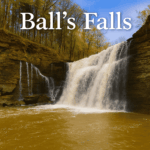Discover how the name Balls Falls originated from the early history of Ontario, Canada, and its connection to local natural features. This charming spot in the Niagara area earned its unique name through a combination of efforts by early settlers and natural landmarks. Visitors often wonder about the story behind the name, and understanding the history can deepen appreciation for this scenic location.
In the 19th century, settlers working along the Niagara River named the waterfalls based on distinctive local features. The term “Balls” is believed to refer to the rounded, boulder-like formations that resemble giant balls. These formations stood out to early explorers and became a recognizable part of the landscape, influencing the name of the falls and the surrounding park. Ontario’s natural environment played a key role in shaping these names, highlighting the region’s geological history and the connection people have maintained with nature for generations.
The name Balls Falls reflects both the area’s physical characteristics and the cultural history of the Niagara region within Ontario, Canada. This site continues to attract visitors who appreciate the blend of natural beauty and historical significance, ensuring that the story of its name remains a meaningful part of the local identity. Exploring these origins offers a glimpse into how natural features influence place names across the Niagara area, preserving the stories of early communities and their environment.
Historical Background: How Balls Falls Got Its Name
The name “Balls Falls” originates from early European settlers who often observed large, rounded stones in the area. These smooth, spherical rocks, scattered along the Niagara River in Ontario, led to the local nickname “Balls,” due to their distinctive shape.
In the 19th century, when the region was still developing, residents and visitors began referring to the scenic waterfall and its surrounding area as “Balls Falls” because of these prominent stones. The name quickly stuck, becoming a familiar reference that highlighted the unique geological features found along the Niagara escarpment in Ontario.
Local lore also links the name to a specific story where early explorers or settlers noticed rounded boulders near the falls, often placing importance on these natural formations. Over time, “Balls” evolved into “Balls Falls,” emphasizing the significance of these stones in the area’s identity.
Impact on Regional Identity
The distinct name helped promote the region as a notable destination within the Niagara area. Visitors recognized Balls Falls not only for its natural beauty but also for its unique geological history, highlighted by the spherical stones that gave the site its name.
Local Legends and Cultural Influences Shaping the Name
The name “Balls Falls” in the Niagara region, Ontario, originates from local stories that add character to the area. According to regional legend, the falls earned their name from early settlers who referred to the rounded, smooth stones found near the waterfall as “balls.” These stones, resembling large, polished spheres, were believed to have special significance in Indigenous culture and early settler folklore.
Another influential story links the name to a playful misinterpretation by European traders and explorers, who associated the round stones with game-like objects or symbolic tokens. Over time, these stories combined with the natural rounded rocks and the distinctive appearance of the waterfall led to the lasting name “Balls Falls.”
Influence of Indigenous and European Traditions
Indigenous communities surrounding Niagara, including the Haudenosaunee and Anishinaabe peoples, have long regarded the stones at the falls as meaningful objects. While specific details may vary, many oral traditions emphasize the spiritual connection to natural features like rocks and waterfalls, which likely influenced local naming conventions.
European settlers and early visitors contributed their own interpretations and stories, emphasizing the interesting shapes of the stones and their perceived “balls.” These stories, passed through generations, cemented the name within local culture and helped forge a unique identity for the site.
Geological and Natural Features that Inspired the Name
Balls Falls gets its distinctive name from the rounded, smooth stones found near the waterfall in Ontario, Canada. These stones are a direct result of the region’s unique geological processes, primarily the erosion caused by flowing water over thousands of years. As the Niagara Escarpment’s limestone formations are worn down, they create spherical shapes that accumulate at the base of the falls, giving rise to the area’s name.
The area’s natural features include the Niagara Escarpment’s rugged limestone cliffs and the creek that feeds into Balls Falls. The constant movement of water erodes softer rock layers, leaving behind more durable and rounded stones. Visitors can observe these polished stones, which resemble small balls, along the creek bed and in the vicinity of the falls. This natural phenomenon not only shaped the landscape but also provided the inspiration for the name, highlighting the region’s distinct geological history.
Unique Geological Composition
The limestone in the Niagara region, rich in marine fossils, resists weathering in specific ways, leading to the formation of these distinctive spherical stones. As water flows over the cliffs and rocks, continuous abrasion smooths out rough edges, creating the polished appearance of the “balls” that inspired the name. Studying these features reveals a history of sedimentation from ancient seas, now exposed through geological uplift and erosion in Ontario, Canada.

